Are you curious about the calories in pork roll and how it can fit into your daily diet? Let’s dive into the surprising facts behind pork roll calories and explore its nutritional information.
Understanding the calories in pork roll is important for those looking to manage their calorie intake and make informed dietary choices. One slice of fried cured pork roll contains 101 calories, with 83% of calories coming from fat, 2% from carbohydrates, and 15% from protein. Pork belly, from which pork roll is made, is also high in calories and fat, with a 4-ounce serving providing 585 calories and 60 grams of total fat. It is best to consume pork belly and pork roll in moderation, as they are high in saturated fat and lower in protein compared to other cuts of pork.
Key Takeaways:
- Pork roll contains 101 calories per slice, with majority of the calories coming from fat.
- Pork roll is made from pork belly, which is also high in calories and fat.
- It is important to consume pork roll in moderation due to its high saturated fat content.
- Pork roll is lower in protein compared to other cuts of pork.
- Understanding the nutritional information of pork roll can help in making informed dietary choices.
What Are Pork Roll Calories Made Of?
Before we dive into the specifics of pork roll calories, it’s essential to understand what they are made of and the potential health benefits this savory treat might offer. Pork roll, also known as Taylor ham, is a popular processed meat product that originated in New Jersey. It is typically made from ground pork, salt, sugar, and spices, which are then shaped into a cylindrical roll and sliced for consumption. While pork roll is beloved for its delicious taste and versatility in various dishes, it’s important to consider its nutritional composition.
One slice of fried cured pork roll contains 101 calories, with 83% of calories coming from fat, 2% from carbohydrates, and 15% from protein. The majority of the fat content in pork roll is saturated fat, which should be consumed in moderation as part of a balanced diet. Consuming high amounts of saturated fat can increase the risk of heart disease and other health issues. Therefore, it’s crucial to be mindful of portion sizes when enjoying pork roll.

Pork belly, from which pork roll is made, is also high in calories and fat. A 4-ounce serving of pork belly provides 585 calories and 60 grams of total fat. While pork roll can be a delicious indulgence, it’s important to remember that it is not a lean source of protein. Other cuts of pork, such as tenderloin or loin chops, offer lower calorie and fat content while still providing ample protein. Understanding the nutritional composition of pork roll can help you make informed dietary choices and find a balance that works for you.
In summary, pork roll calories primarily come from fat, with moderate amounts of protein and carbohydrates. When consumed in moderation and as part of a balanced diet, pork roll can be enjoyed as a tasty treat. However, it’s essential to be mindful of portion sizes and consider other cuts of pork that offer lower calorie and fat content. By understanding the nutritional composition of pork roll, you can make informed decisions about incorporating it into your diet.
The Calorie Count of Pork Roll: A Slice by Slice Breakdown
Let’s narrow our focus and take a closer look at the calorie count of pork roll, slice by slice, to get a better understanding of its impact on your daily caloric intake. One slice of fried cured pork roll contains approximately 101 calories. It’s important to note that the majority of these calories, about 83%, come from fat, while only 2% come from carbohydrates and 15% from protein.
To put it into perspective, let’s compare the calorie count of pork roll to that of its source, pork belly. A 4-ounce serving of pork belly, from which pork roll is made, provides a whopping 585 calories and 60 grams of total fat. This highlights the fact that both pork belly and pork roll are high in calories and fat. While pork roll offers a slightly lower calorie count per slice, it is still important to consume it in moderation.
| Calorie Content | Fat Content | Carbohydrate Content | Protein Content |
|---|---|---|---|
| One Slice of Pork Roll | Approximately 101 calories | 2% | 15% |
| Four-Ounce Serving of Pork Belly | 585 calories | – | – |
It’s worth noting that both pork belly and pork roll are higher in saturated fat and lower in protein compared to other cuts of pork. Therefore, it’s advisable to balance your diet with a variety of leaner protein sources and incorporate pork roll as an occasional treat rather than a dietary staple.
Understanding the calorie count of pork roll is essential for making informed dietary choices. By being aware of the calories and nutritional composition of each slice, you can better manage your overall calorie intake and enjoy pork roll responsibly as part of a balanced diet.
- Pork Roll Nutritional Facts
- Tips for Portion Control when Consuming Pork Roll
- Exploring Low Calorie Pork Roll Alternatives
The Connection Between Pork Roll and Weight Loss
Can pork roll be a part of a weight loss journey? Let’s uncover the connection between pork roll and weight loss and explore the possibilities of incorporating it into a balanced diet.
Understanding the calories in pork roll is essential for managing your calorie intake while enjoying this savory treat. One slice of fried cured pork roll contains 101 calories, with 83% of calories coming from fat, 2% from carbohydrates, and 15% from protein. While pork roll can fit into a weight loss plan, it’s important to consider portion sizes and overall calorie consumption.
| Calories | Fat | Carbohydrates | Protein |
|---|---|---|---|
| 101 | 83% | 2% | 15% |
Pork roll is made from pork belly, which is also high in calories and fat. A 4-ounce serving of pork belly provides 585 calories and 60 grams of total fat. It’s important to moderate your consumption of pork belly and pork roll due to their high saturated fat content and lower protein content compared to other cuts of pork.
Exploring Low Calorie Pork Roll Alternatives
If you’re watching your calorie intake but still want to enjoy the flavors of pork roll, consider exploring low calorie alternatives. These options offer a healthier choice without compromising on taste. Look for low calorie pork roll made with leaner cuts of pork and reduced fat content. Incorporating these alternatives into your diet can help you manage your weight while still satisfying your cravings.
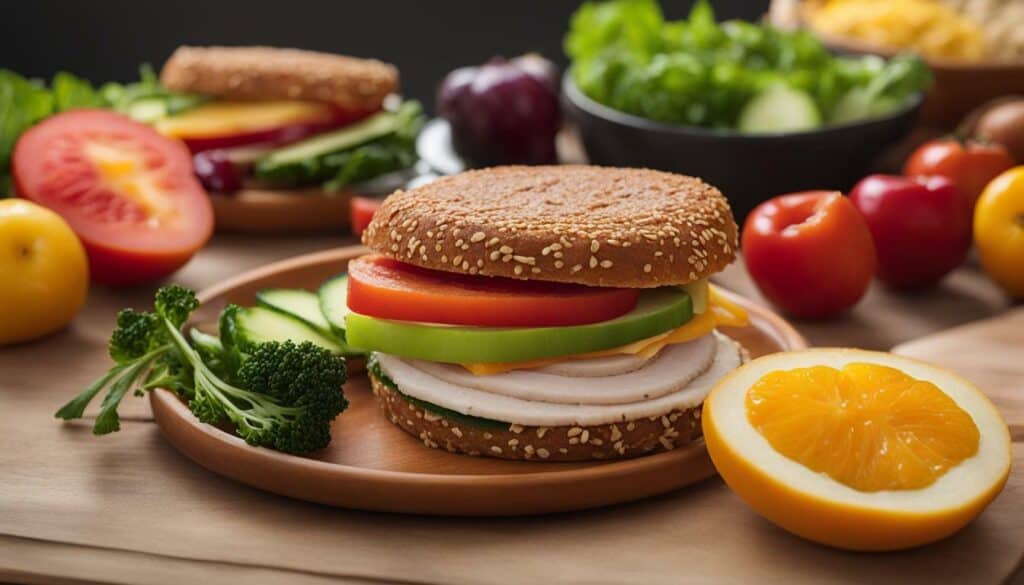
Remember, incorporating pork roll into a balanced diet is about finding the right balance. Pay attention to portion sizes, frequency of consumption, and pairing with nutrient-rich foods. By making mindful choices and being aware of your overall calorie intake, you can enjoy pork roll while still working towards your weight loss goals.
Pork Roll and Nutrition Facts: What You Need to Know
Beyond its calorie count, pork roll boasts a range of nutritional elements. Let’s dive into the nutrition facts and explore the potential health benefits and considerations tied to consuming pork roll.
One slice of fried cured pork roll contains 101 calories, with 83% of calories coming from fat, 2% from carbohydrates, and 15% from protein. While pork roll may be high in calories and fat, it does offer some nutritional value. It is a good source of protein, providing essential amino acids that our bodies need for growth and repair. Additionally, pork roll contains vitamins and minerals such as vitamin B12, zinc, and selenium. These nutrients play important roles in energy production, immune function, and maintaining healthy skin and hair.
However, it is important to note that pork roll and the cuts of pork it is made from, such as pork belly, can be high in saturated fat. Consuming too much saturated fat can increase the risk of heart disease. It’s recommended to consume pork roll in moderation and opt for leaner cuts of pork, such as loin or tenderloin, which contain less fat and calories. Pairing pork roll with nutrient-rich vegetables and whole grains can help create a balanced meal.
| Nutrient | Amount per Slice |
|---|---|
| Calories | 101 |
| Total Fat | 9g |
| Saturated Fat | 3g |
| Carbohydrates | 1g |
| Protein | 4g |
| Vitamin B12 | 0.6mcg |
| Zinc | 0.5mg |
| Selenium | 8.5mcg |
When incorporating pork roll into your diet, it’s crucial to prioritize portion control and be mindful of your overall calorie intake. Enjoying pork roll as an occasional treat can be a part of a balanced diet. Be sure to listen to your body’s hunger and fullness cues, and make choices that align with your individual health goals and dietary needs.
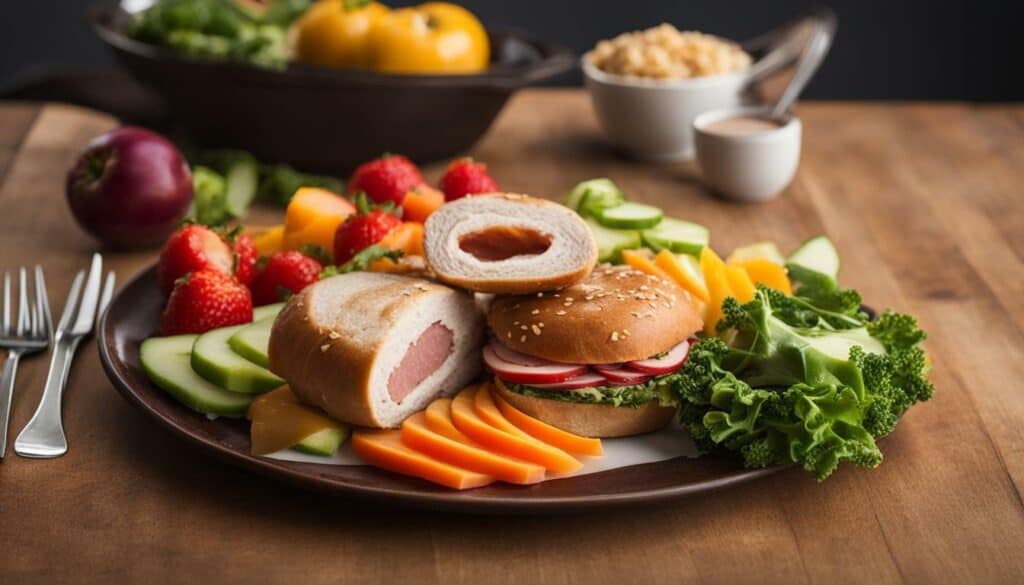
By understanding the nutrition facts and making informed choices, you can still enjoy the flavors of pork roll while maintaining a healthy and balanced lifestyle.
Pork Roll vs. Other Cuts of Pork: A Comparison
How does pork roll stack up against other cuts of pork in terms of nutrition? Let’s compare the fat content, protein content, and health benefits of pork roll to other popular pork cuts.
When it comes to fat content, pork roll and pork belly are on the higher end. One slice of fried cured pork roll contains 101 calories, with 83% of calories coming from fat. Similarly, a 4-ounce serving of pork belly provides 585 calories and 60 grams of total fat. It’s important to consume these cuts of pork in moderation, as they are high in saturated fat.
In terms of protein content, pork roll falls slightly behind other cuts of pork. While 15% of the calories in a slice of pork roll come from protein, other leaner cuts like pork tenderloin and pork loin have a higher protein content. For example, a 4-ounce serving of pork tenderloin contains 24 grams of protein, making it a better option for those looking to increase their protein intake.
When considering the health benefits, it’s worth noting that pork roll is a processed meat, whereas other cuts of pork can be leaner and less processed. Processed meats have been linked to an increased risk of certain health conditions, including heart disease and colon cancer. On the other hand, lean cuts of pork, like pork tenderloin and pork loin, can provide essential nutrients like iron, zinc, and B vitamins without the added drawbacks of processed meats.
In summary, while pork roll may be a flavorful and indulgent choice, it’s important to enjoy it in moderation due to its high fat content. If you’re looking for a healthier option, lean cuts of pork like pork tenderloin and pork loin are better choices, offering higher protein content and fewer drawbacks associated with processed meats. Remember to balance your diet with nutrient-rich foods and practice portion control to ensure a well-rounded and health-conscious approach to enjoying pork.
Moderation Matters: Enjoying Pork Roll Responsibly
While there are health benefits associated with pork roll, it’s crucial to enjoy this delicious treat in moderation to maintain a balanced diet and make the most of its positive attributes. Understanding the calories in pork roll is important for those looking to manage their calorie intake and make informed dietary choices.
One slice of fried cured pork roll contains 101 calories, with 83% of calories coming from fat, 2% from carbohydrates, and 15% from protein. It’s important to note that pork belly, from which pork roll is made, is also high in calories and fat. A 4-ounce serving of pork belly provides 585 calories and 60 grams of total fat.
| Nutrient | Calories per Slice | Percentage (%) |
|---|---|---|
| Fat | 84 | 83% |
| Carbohydrates | 2 | 2% |
| Protein | 15 | 15% |
Consuming pork roll and pork belly in moderation is recommended due to their high saturated fat content. While fat adds flavor and richness, excessive consumption can contribute to weight gain and increase the risk of heart disease. It’s essential to balance pork roll with other nutrient-rich foods and incorporate regular exercise into your lifestyle.

Incorporating leaner cuts of pork, such as tenderloin or loin chops, into your diet can provide a healthier alternative to pork roll. These cuts are lower in calories and fat while still offering a good source of protein. Pairing pork roll with fiber-rich vegetables, whole grains, and other lean proteins can help create a balanced meal that satisfies your cravings without compromising your health goals.
Remember:
- Enjoy pork roll in moderation.
- Be mindful of portion sizes.
- Balance pork roll with other nutrient-rich foods.
- Incorporate regular exercise into your lifestyle.
By practicing moderation and making mindful choices, you can enjoy the indulgent flavors of pork roll while maintaining a healthy and balanced diet.
Tips and Tricks: Managing Pork Roll Calories in Your Diet
Let’s explore some useful tips and tricks for incorporating pork roll into your diet while effectively managing its calories, whether you’re looking for weight loss or simply maintaining a healthy lifestyle.
Firstly, portion control is key when it comes to enjoying pork roll without overindulging on calories. One slice of fried cured pork roll contains approximately 101 calories, so being mindful of the number of slices you consume can make a significant difference in your daily caloric intake. Consider using a food scale or measuring cups to accurately portion out your serving size.
In addition to portion control, you can also opt for healthier cooking methods to reduce calories. Instead of frying pork roll, try grilling or baking it. This will help minimize the amount of added fat while still maintaining its delicious flavor. Pairing pork roll with nutrient-rich ingredients, such as vegetables or whole grains, can also help balance out the overall nutritional value of your meal.
| Portion Control Tips | Healthier Cooking Methods | Nutrient-Rich Pairings |
|---|---|---|
|
|
|
When incorporating pork roll into your diet, it’s important to note that it is high in saturated fat and lower in protein compared to other cuts of pork. While it can be enjoyed as an occasional treat, moderation is key. To promote overall weight loss or maintain a healthy lifestyle, it’s crucial to focus on a balanced and varied diet that includes a wide range of nutritious foods.
Remember, understanding the calories in pork roll and implementing these tips and tricks can help you enjoy this delicious and flavorful food while still managing your caloric intake. With moderation, portion control, and mindful choices, you can savor the taste of pork roll without compromising your health goals.
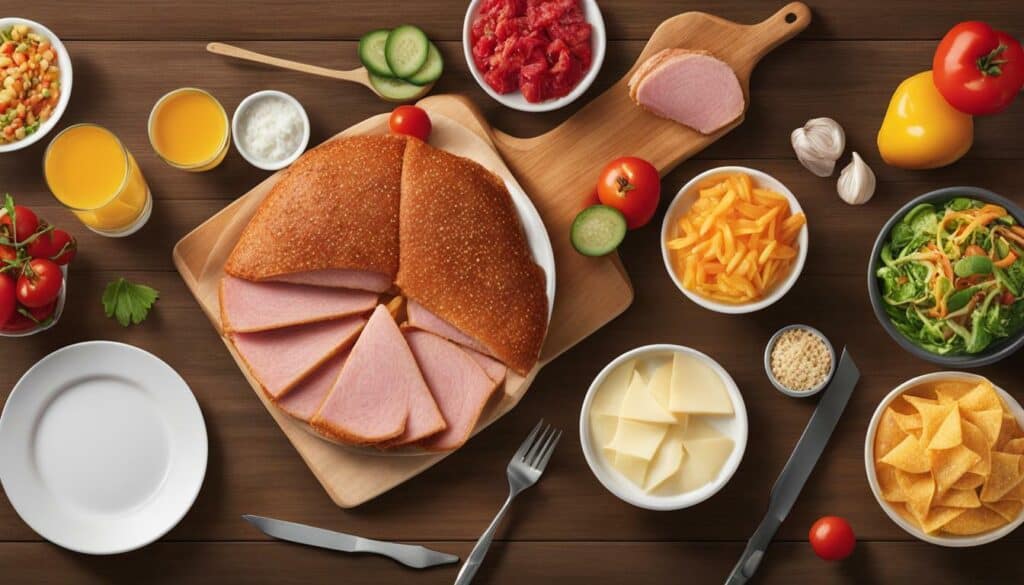
If you’re looking to indulge in pork roll while keeping your calorie count in check, consider exploring low calorie alternatives that offer the same delicious flavor with fewer calories. There are several options available that can satisfy your cravings without compromising your dietary goals.
One popular choice is turkey roll, which is made from lean turkey breast. It provides a similar texture and taste to pork roll but with significantly fewer calories and less fat. A typical slice of turkey roll contains only 25 calories, making it a great low calorie substitute. Additionally, turkey is a lean protein source and is rich in vitamins and minerals, making it a healthier alternative.
Another option to consider is chicken roll. This alternative is made from lean chicken breast and is lower in calories and fat compared to traditional pork roll. A slice of chicken roll typically contains around 30 calories, making it a guilt-free choice. Chicken is also a great source of protein and is lower in saturated fat, making it a healthier choice for those watching their calorie intake.
Comparison of Pork Roll Alternatives
| Alternative | Calories per Slice | Fat per Slice | Protein per Slice |
|---|---|---|---|
| Turkey Roll | 25 | 1g | 3g |
| Chicken Roll | 30 | 1.5g | 4g |
| Pork Roll | 101 | 9g | 4g |
As you can see from the table above, both turkey roll and chicken roll provide lower calorie and fat options compared to traditional pork roll. They still offer a good amount of protein, making them suitable choices for those looking to maintain a balanced diet.
By opting for these low calorie alternatives, you can enjoy the flavors of pork roll while reducing your calorie intake. Remember to always check the nutritional information on the packaging to ensure you are making the best choice for your dietary needs. So go ahead and savor the taste of pork roll guilt-free with these delicious low calorie options!
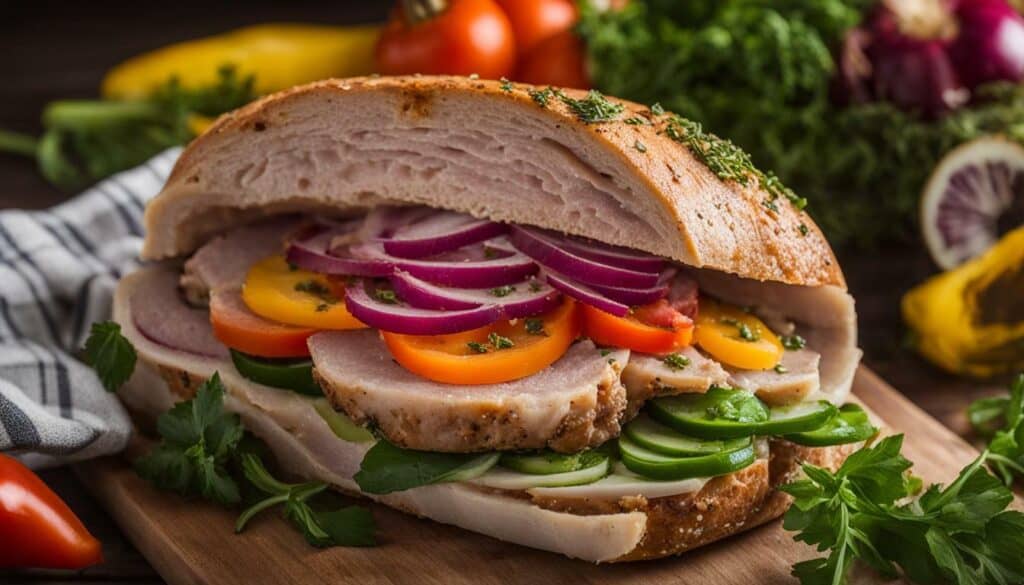
It is possible to enjoy pork roll as part of a balanced diet. Let’s explore how to find the right balance by considering portion sizes, frequency of consumption, and what to pair it with for a more nutritious meal.
When it comes to portion sizes, moderation is key. One slice of fried cured pork roll contains approximately 101 calories, so it’s important to be mindful of how many slices you consume. Opting for a smaller portion can help you manage your calorie intake while still satisfying your cravings. Consider adding other lean protein sources, like grilled chicken or turkey, to your meal to boost its nutritional value.
Frequency of consumption is another factor to consider. While pork roll can be enjoyed from time to time, it’s best to limit its consumption due to its high calorie and fat content. Incorporate it into your diet occasionally, rather than making it a staple food. Remember, variety is key when it comes to a well-balanced diet.
Pairing pork roll with nutrient-rich foods can help create a more balanced and satisfying meal. Include a variety of vegetables, whole grains, and healthy fats to round out your plate. This not only provides additional vitamins and minerals but also helps create a more filling and satisfying meal. For example, you can enjoy pork roll in a whole-wheat wrap with spinach, tomatoes, and avocado for added fiber and heart-healthy fats.
| Nutrient | Per Slice (Approx.) |
|---|---|
| Calories | 101 |
| Total Fat | 9g |
| Carbohydrates | 0.5g |
| Protein | 4g |
Incorporating pork roll into a balanced diet is possible, but it’s essential to be mindful of portion sizes, frequency of consumption, and pairing it with nutrient-rich foods. By practicing moderation and making thoughtful food choices, you can enjoy pork roll without compromising your overall health and wellness.
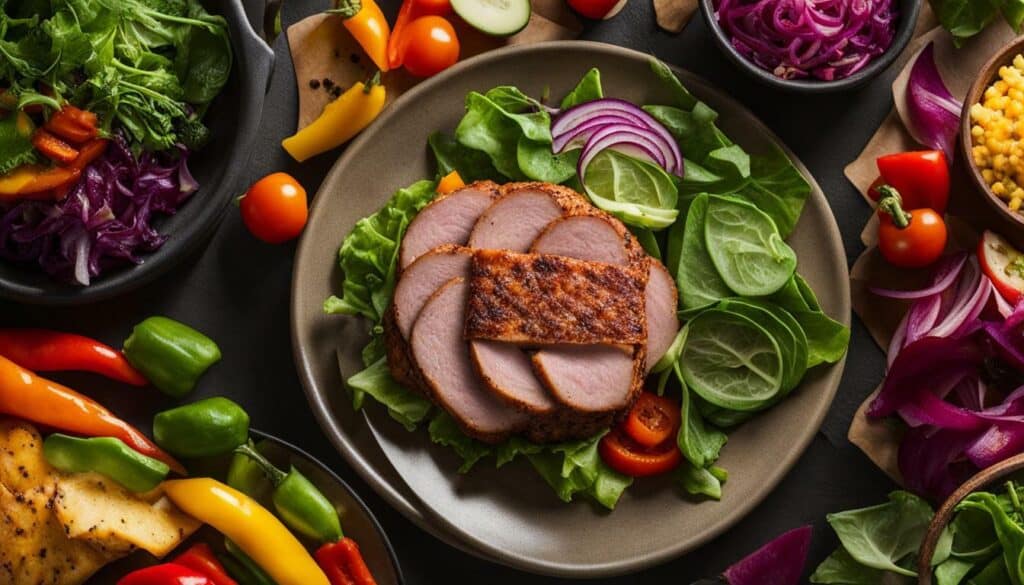
As with any food, it’s important to listen to your body and make choices that align with your individual health goals. Consulting with a registered dietitian or healthcare professional can provide personalized guidance and support.
Remember, balance is the key to a healthy lifestyle, and enjoying your favorite foods, like pork roll, can be part of that balance when approached with mindfulness and consideration for overall nutrition.
Conclusion
Understanding pork roll calories is crucial for making informed dietary choices. By managing portion sizes and incorporating it into a balanced diet, you can enjoy this savory treat while maintaining a healthy lifestyle.
One slice of fried cured pork roll contains approximately 101 calories, with the majority of calories coming from fat. While pork roll can be a delicious addition to meals, it’s important to consume it in moderation due to its high calorie and fat content.
It’s worth noting that the main ingredient in pork roll, pork belly, is also high in calories and fat. A 4-ounce serving of pork belly provides approximately 585 calories and 60 grams of total fat. Therefore, it’s advisable to exercise moderation when consuming pork belly and pork roll, as they are higher in saturated fat and lower in protein compared to other cuts of pork.
By incorporating pork roll into a balanced diet and being mindful of portion sizes, you can indulge in this flavorful treat without compromising your health goals. Remember to choose leaner cuts of pork for a healthier alternative and pair your pork roll dishes with nutrient-rich foods to ensure a well-rounded meal.
FAQ
Q: What is the calorie content of pork roll?
A: One slice of fried cured pork roll contains 101 calories.
Q: What percentage of calories in pork roll come from fat?
A: Approximately 83% of the calories in pork roll come from fat.
Q: How many carbohydrates are in pork roll?
A: Only 2% of the calories in pork roll come from carbohydrates.
Q: What is the protein content of pork roll?
A: Pork roll contains 15% of its calories from protein.
Q: How many calories are in a serving of pork belly?
A: A 4-ounce serving of pork belly provides 585 calories.
Q: How much fat is in pork belly?
A: A 4-ounce serving of pork belly contains 60 grams of total fat.
Q: Is pork roll high in saturated fat?
A: Yes, pork roll is high in saturated fat and should be consumed in moderation.
Q: How does pork roll compare to other cuts of pork in terms of protein content?
A: Pork roll is lower in protein compared to other cuts of pork.
Q: What are the potential health benefits of pork roll?
A: Aside from its calorie content, pork roll may provide certain health benefits.
Q: Can pork roll be part of a weight loss diet?
A: Pork roll can be consumed in moderation as part of a balanced weight loss diet.
Q: What other nutrition facts should I know about pork roll?
A: Pork roll has additional nutritional characteristics beyond its calorie count.
Q: How does pork roll compare to other cuts of pork in terms of fat content?
A: Pork roll is typically higher in fat compared to leaner cuts of pork.
Q: Is it possible to enjoy pork roll while managing calorie intake?
A: Yes, consuming pork roll responsibly and in moderation is key.
Q: Any tips for managing pork roll calories in my diet?
A: Practical tips and tricks can help you manage pork roll calories within your diet.
Q: Are there any low calorie alternatives to traditional pork roll?
A: Yes, low calorie alternatives to traditional pork roll are available.
Q: Can pork roll be part of a balanced diet?
A: Pork roll can be incorporated into a balanced diet with proper portion control and accompanying nutrient-rich foods.
How Many Calories are in a Pork Roll Sandwich Roll?
A pork roll sandwich roll typically contains around 300-400 calories in sandwich roll, depending on the size and ingredients used. It is important to note that the addition of condiments or extras, such as cheese or mayonnaise, can significantly increase the calorie content.





Leave a Reply